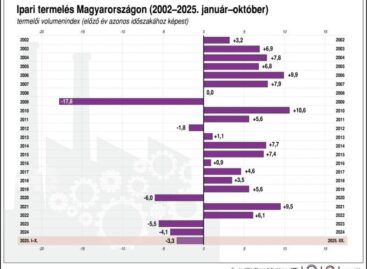Thousands of shops closed in Hungary last year
Last year, thousands of shops and restaurants closed in Hungary, which experts primarily attribute to high energy prices, declining consumption, and a weak forint compared to the euro.

By the end of the year, there were a total of 107,000 establishments operating in the country, 4,600 fewer than the previous year. Used goods stores were the hardest hit, experiencing a 6.6% decrease, followed by textile and clothing stores with nearly a 6% drop. In the three years before the pandemic, approximately 12,000 shops closed, amounting to a 10% decline. Since the pandemic, the number of textile and clothing stores decreased by 16.8%, while used goods stores saw a decline of over 22%. The main reasons for these closures were attributed to high energy prices, reduced consumption, and the weak forint, as highlighted by Haszon.hu.
The Hungarian hospitality industry also suffered due to the global pandemic, energy crisis, high inflation, declining demand, and an uncertain economic environment. According to data from the Central Statistical Office (KSH), in 2022, there were less than 47,000 hospitality establishments in Hungary, including restaurants, buffets, pastry shops, liquor stores, music entertainment venues, and establishments providing workplace, event, and public catering services. After excluding public catering units, less than 40,000 commercial hospitality venues remained, showing a significant decline compared to the previous decade when the number exceeded 50,000.
The number of restaurants and buffets fluctuated between 25,000 and 26,000 over the past ten years, but due to the pandemic, by the end of 2022, only 23,181 were in operation. However, pastry shops were in a somewhat more fortunate position, and their numbers increased during the past decade. The reason for this growth is their relatively more predictable operations compared to restaurants.
However, the number of liquor stores and music entertainment venues continuously decreased over the past decade, even before the pandemic. In 2010, there were over 21,000 such establishments in Hungary, but by the start of the pandemic, this number decreased to around 15,000, and by the end of 2022, it further declined to 12,600.
On the other hand, the number of workplaces, event venues, and establishments providing public catering services increased over the past years. By the end of 2022, there were more than 7,000 such units, significantly higher than the 5,600 units that existed in the early 2010s.
Related news
Apples have become significantly more expensive in Hungary
🎧 Hallgasd a cikket: Lejátszás Szünet Folytatás Leállítás Nyelv: Auto…
Read more >KSH: industrial production decreased by 2.7 percent in October compared to the same period of the previous year, and increased by 0.5 percent compared to the previous month
🎧 Hallgasd a cikket: Lejátszás Szünet Folytatás Leállítás Nyelv: Auto…
Read more >No more “pig in a poke” in hospitality: How Eventrend Group reformed workforce management with the help of Giggle
🎧 Hallgasd a cikket: Lejátszás Szünet Folytatás Leállítás Nyelv: Auto…
Read more >Related news
2026 begins in agriculture amid crises and a wave of investment – banking focuses on the dairy and pig markets, as well as CAP investments
🎧 Hallgasd a cikket: Lejátszás Szünet Folytatás Leállítás Nyelv: Auto…
Read more >Sovereignty Protection Office: According to the public, there is no place for foreign majority ownership in strategic sectors
🎧 Hallgasd a cikket: Lejátszás Szünet Folytatás Leállítás Nyelv: Auto…
Read more >Poor fruit harvest weighs on the pálinka sector
🎧 Hallgasd a cikket: Lejátszás Szünet Folytatás Leállítás Nyelv: Auto…
Read more >







